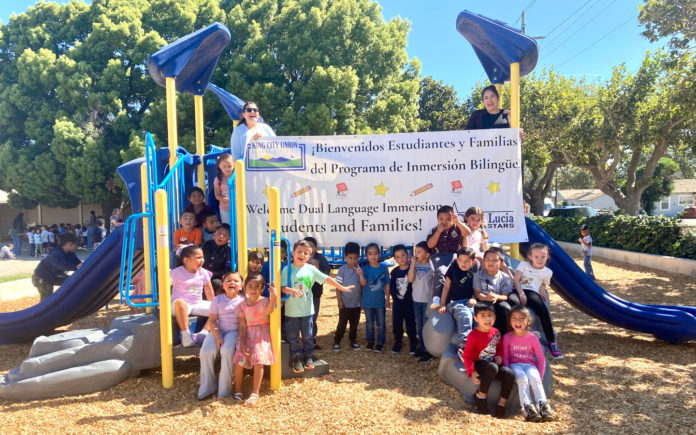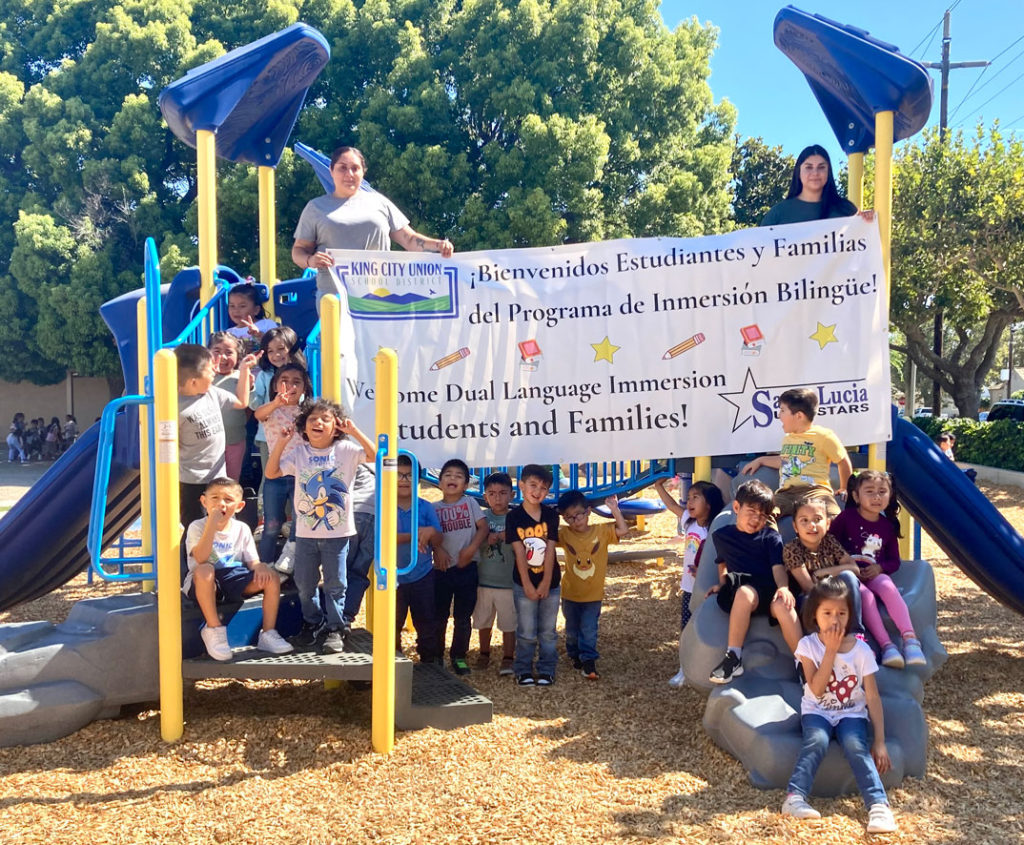
KING CITY — Students from three classrooms at Santa Lucia Elementary School in King City have completed their first month of the Dual Language Immersion (DLI) program.
The new program, launched this school year, teaches students from all backgrounds in a blend of Spanish and English with the goal of having the youth be able to read, write and speak in two languages by the end of their elementary school journey.
“This is the biggest opportunity that has happened in King City education in the last 25 years,” said teacher Ana Alvarez.
Alvarez explained that families can feel more empowered in helping with bilingual homework or can understand the lesson when they visit a classroom. In the long term, she said area agriculture companies have informed the school future employees and managers will be on a much better footing if they’re bilingual.
The DLI program launched in three classrooms at Santa Lucia, two at the kindergarten level and one at the transitional kindergarten (TK) level. The foundation begins with a 90/10 split in exposure to languages at the school, with Spanish taking up the majority of instruction. Students enrolled are split evenly between those who speak only English, those who speak only Spanish and emerging bilingual speakers.
“To make sure we are giving a firm foundation in Spanish to build upon, the teachers spend 90 percent of their time instructing in Spanish and only 10 percent of the time is in English,” said Jennifer Taylor, superintendent of King City Union School District.
Over the years, the split will even out. Taylor said districts tend to see a 50/50 split somewhere around fourth grade, but noted the speed at which students learn both languages can vary. A successful outcome would be a Seal of Biliteracy from the state upon graduating high school.
In the TK classroom during their third week, teacher Marco Rivera took roll call but had students count out how many students there were in attendance, all in Spanish and up to 23. Then he and paraprofessional Karla Chavez led the students in a Spanish song to begin their day.
Next door, in Rosa Ochoa’s kindergarten classroom, the instruction was in Spanish. The students heard a lesson about the months, as well as did worksheets on the month of August, learned about the color yellow and identified the letter H — all while paraprofessional Liz Serrano helped them in Spanish.
School Board President Terry Garcia visited the classrooms two weeks into the school year. The students at first asked her, “Who are you?” but when reminded to use what they’ve learned on Spanish, switched to “Como te llamas?” and when they exchanged names with the board president, rather than simply saying their name, began with, “me llamo.”
“We’ve been in school for two weeks and they are already learning the language, interacting with each other, learning the culture from each other, it’s something almost magical,” Alvarez said of the 4-year-olds who began the year speaking English only.

Alvarez credited board members Vina Paramo and Susan King with pushing for the program’s implementation. She said schools typically have to convince boards to begin dual immersion, but in King City, they were already supportive of the program.
Alvarez explained the new model differs from past bilingual education in that the goal isn’t English-only learning. Under a typical program, students would come in speaking Spanish and over the years shift toward learning only in English.
“It promotes that you don’t have to sacrifice one language to learn another,” Alvarez said of the DLI program. “For the last 25 years, our kids have been coming to school speaking Spanish, but by the time they get to first grade, they have forgotten their native language and then they cannot communicate with their parents.”
Taylor noted the district already sent communications with families out in bilingual form, and had materials in both languages at the school libraries, but the instruction was focused toward English.
“That missing component has been teaching the students in both languages and having them become biliterate in both languages,” Taylor explained.
The communication in two languages is not limited to the three classrooms, but everywhere on campus.
Principal Mel Kuchta said staff is on board and speaks to the students in both languages, and other teachers are considering the certification needed to become DLI instructors. Visitors to classrooms need to either speak in Spanish for the immersion, or get help translating from staff, such as one of the paraprofessionals in the room.
“We do morning announcements every day and have been involving the students with sending a student up that says the announcement in English and another in Spanish,” Kuchta said.
Alvarez added, “I have to say the first day I heard the announcements in Spanish, I cried because I’ve been waiting for this for almost 25 years now.”
“Those involved directly with the program are faithful to using Spanish, so we can see the results we’re seeing so quickly,” Taylor said.
Taylor noted that a task force has been set up to evaluate the results of the program to see how to move forward as the students progress toward eighth grade.
“One of the advantages of starting small with TK/K is we’ll be watching the students from the very beginning as they grow through this program and taking it slow to make sure we develop this correctly,” she said.
Looking ahead, Taylor said the state testing that begins in third grade will be a challenge, but a temporary challenge, based on their research and visits to schools across the state.
“The first time you test students in third grade for a state test in English and if the students have spent the majority of their instruction in Spanish, obviously that’s going to be difficult,” she said. “Yes, third grade testing is going to be difficult, but what we know over time is, our bilingual and biliterate students outperform their peers in the long run. You have to be patient learning through the process.”
Ten parent meetings were held before the school year began to enroll students in the TK and kindergarten portions of the program. Next year, those students will advance to first grade and kindergarten, and Taylor said there are expected enrollment opportunities in kindergarten and TK. She said parents should watch for informational meetings if they’re considering enrolling their child in the ongoing program.














